Sky (formerly MakerDAO) has seen its token price reset to early levels, returning to the $1.1k–$1.3k range seen just before last year’s brief bull market. This decline has largely stemmed from recent DeFi and Ethereum sector underperformance, rebranding uncertainties, and the emergence of a strong competitor, Ethena.
However, the outlook is ripe for a shift. Sky’s strategic initiatives are gaining traction, with near-term catalysts ready to drive momentum. Key developments include the Seal Module (activating fee switch), strictly deflationary tokenomics, Sky’s Solana launch, and the highly anticipated integration of Sky Aave Force.
With robust top-line growth and an attractive valuation, Sky continues to lead in the decentralized stablecoin space. Now is the time to take notice: as the DeFi Renaissance unfolds, Sky is well-positioned to stand at its forefront.
While the crypto market remains captivated by AI and memecoins, Sky (formerly MakerDAO) seems to have slipped from its former prominence. This shift is reflected in the price of $MKR, which has declined to the $1,100–$1,300 range as of November 5, 2023—levels reminiscent of those just before last year’s brief bull market. This drop has reinforced the view that $MKR may no longer be capturing investor attention.
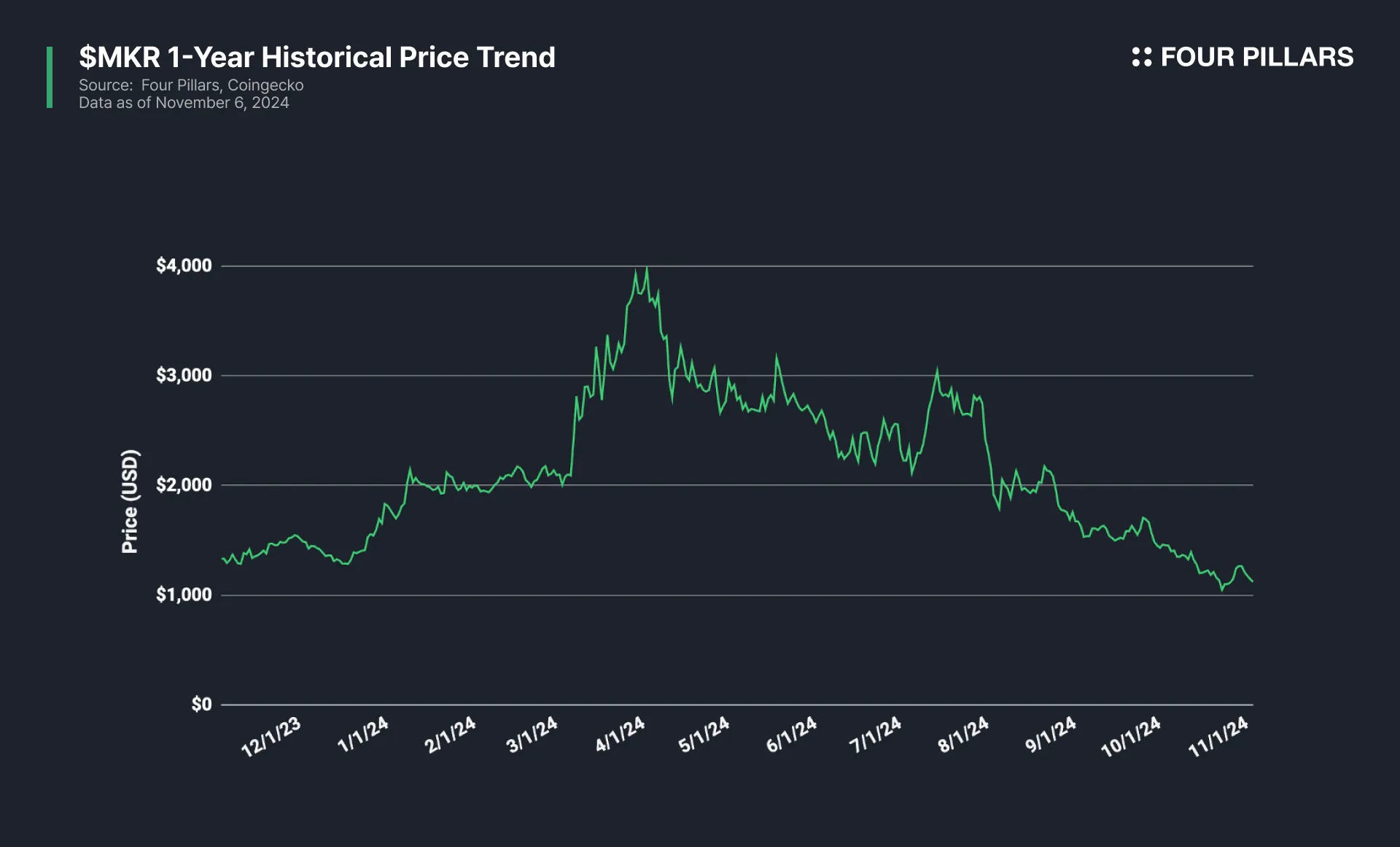
Yet, it’s worth reconsidering whether this perception accurately reflects Sky’s present and future potential. This report delves into the underlying causes of $MKR’s recent performance and builds a case for why Sky deserves renewed focus. By examining Sky’s recent achievements, forthcoming changes to its tokenomics, and its enduring position as the longest-standing and most trusted decentralized stablecoin, we aim to make a compelling argument for Sky’s well-deserved revaluation.
On September 18, 2023, MakerDAO completed its long-awaited rebranding to Sky, a milestone in the project’s Endgame roadmap. Approved by governance in August 2022, Endgame is Sky’s long-term roadmap aimed at solidifying its leadership in DeFi and ultimately expanding $DAI issuance to $100 billion. As part of this shift, MakerDAO launched a revamped front-end with improved UI/UX, rebranded $MKR as $SKY and $DAI as $USDs, and set a 1:24,000 exchange ratio between $MKR and $SKY on Sky.money. To further encourage conversions between $DAI and $USDs, the project introduced incentives like Sky Token Rewards.
However, community reactions to the rebranding have been mixed. While some members value the established trust in the MakerDAO brand and have chosen to retain their original tokens, the coexistence of $MKR and $SKY alongside $DAI and $USDs has introduced confusion towards each token’s utility.
“It is now clearer than ever how much the DeFi community loves and trusts the Maker brand. There’s a strong affinity for what it represents—stability, security, and DeFi scale. Many are committed to holding MKR rather than upgrading to SKY.”
Rune Christensen, Founder of Sky
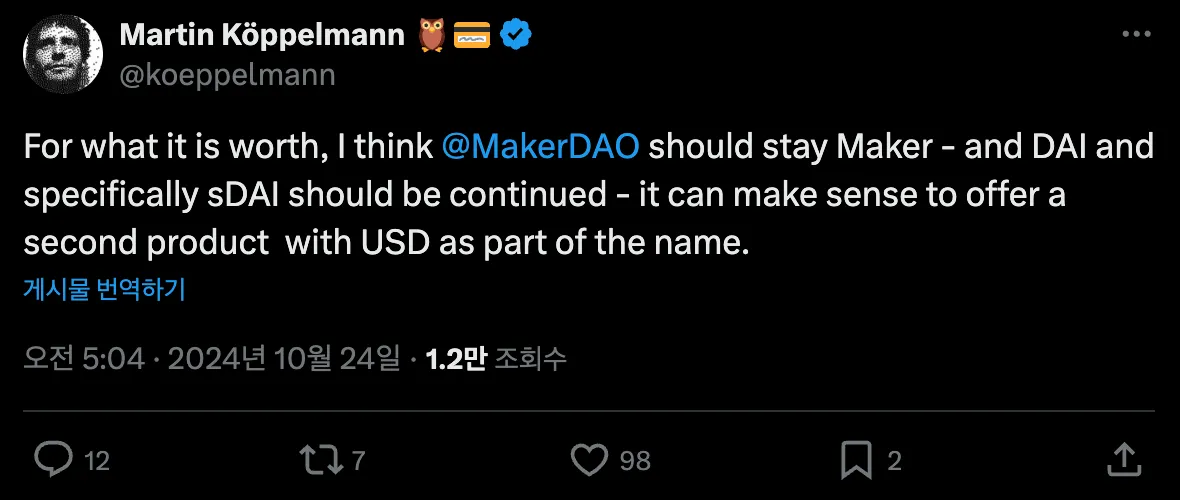
Source: X (@koeppelmann)
Further complicating matters, Sky’s founder, Rune Christensen, confirmed that the original $MKR and $DAI tokens would remain valid, creating additional uncertainty about the roles and utility of both new and old tokens. Adding to the challenge, centralized exchanges like Coinbase announced they would not support $SKY migration, increasing market concerns about the rebranding’s broader acceptance.
In response to the situation, Rune Christensen initiated a governance vote on November 4, 2024, to determine whether to revert to the MakerDAO brand. The vote concluded on November 8 with a decision to retain the rebranding and move forward as planned. Consequently, Sky will remain the core brand of the Sky ecosystem and protocol, with the transition from $MKR to $SKY and from $DAI to $USDs set to proceed without further brand-related adjustments. While initial reactions were mixed, the community’s decision to support the rebranding signals that Sky is now poised to enter a new phase with strengthened focus and direction.
The launch of Ethena in February 2024 has added pressure to $DAI’s market share, contributing to the recent decline in $MKR’s price. Ethena, an Ethereum-based synthetic dollar asset protocol, reached $3 billion in market cap within just four months of launch. As of November 5, 2023, Ethena’s $USDe holds a 22.4% share of the decentralized stablecoin market. This rapid ascent is largely driven by Ethena’s attractive interest rates, sustained by three primary revenue sources. For further details, refer to “The Verge of Crypto Dollar War and Strategy of Ethena (Feat. UStb, Network).”
Staking Rewards: Ethena leverages Ethereum’s PoS mechanism, earning interest through staked tokens like stETH.
Market Strategy: By employing a delta-neutral approach, Ethena capitalizes on funding and basis spreads in perpetual futures and derivatives markets. This involves holding long positions on spot assets and short positions in perpetual futures to monetize funding rates.
Stablecoin Interest Rate: Ethena also generates returns through two primary stablecoin investments—first, accruing revenue from 295 million USDC via Coinbase’s royalty program, and second, earning interest on 400 million sUSDS through borrowing fees from Sky.
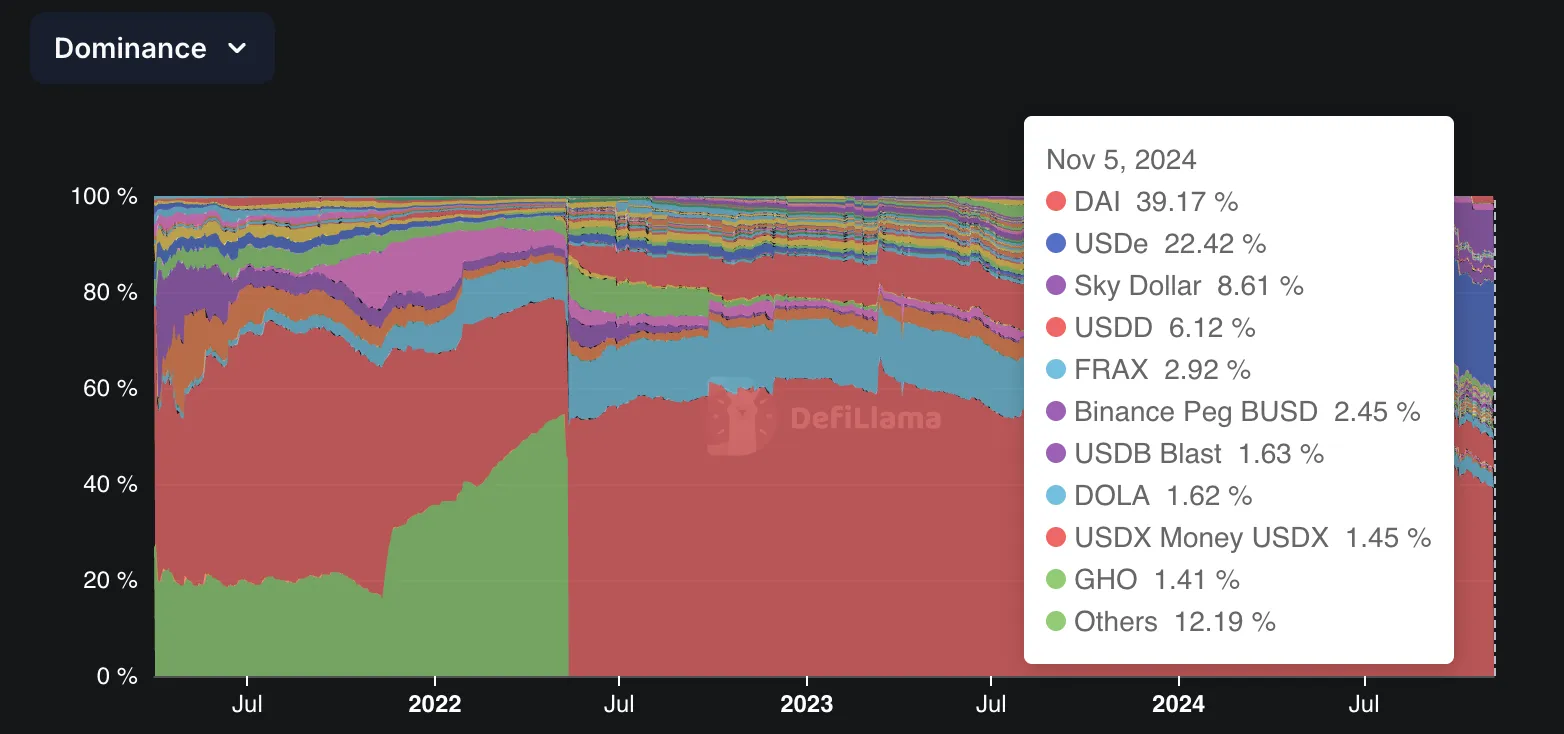
Source: Defillama
As of late October, $USDe’s yield stands at 13.3%, significantly higher than Sky’s SSR of 6.5%. While questions remain about the sustainability of such high rates and Ethena’s overall stability, the protocol has so far operated smoothly.
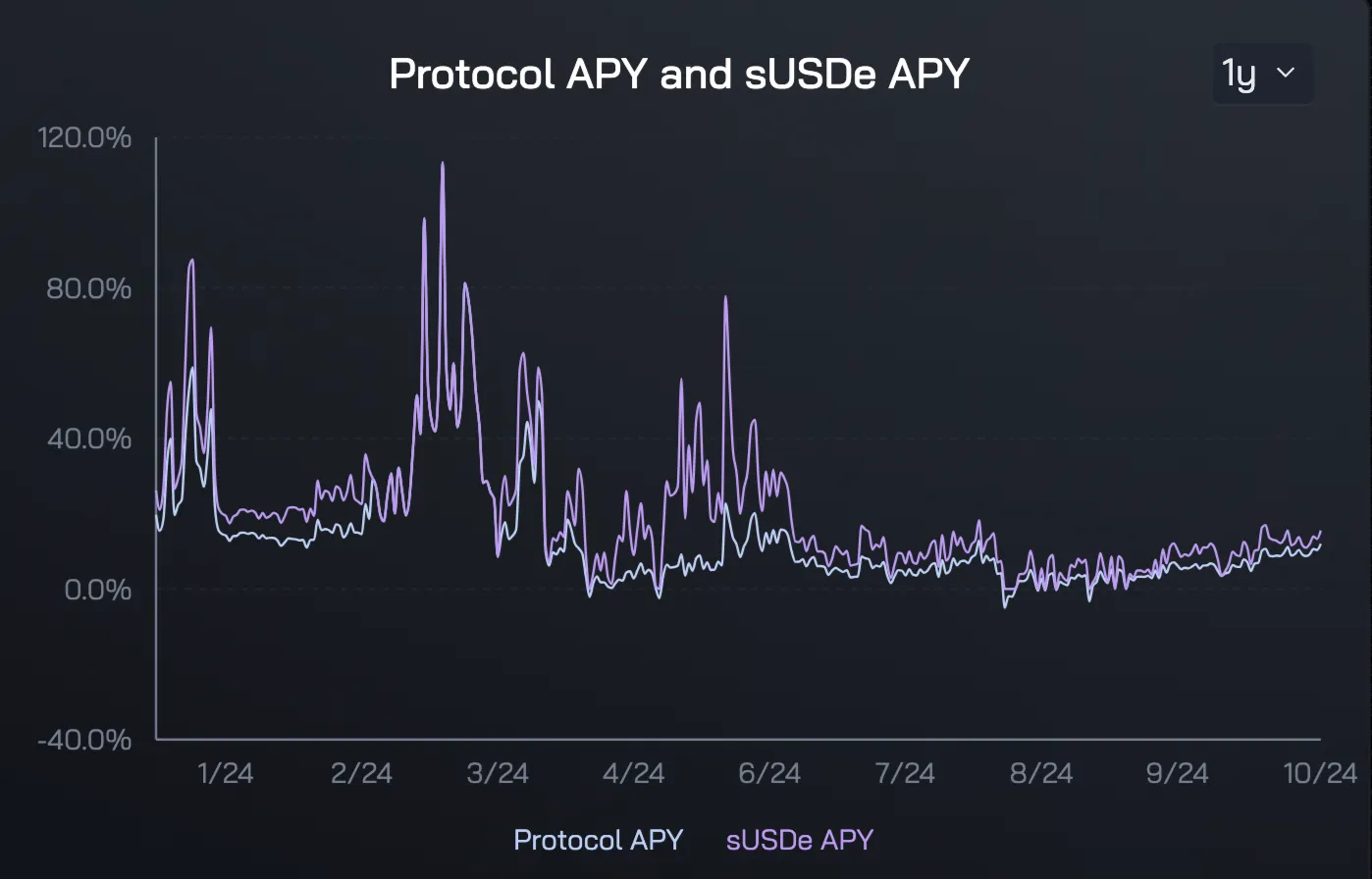
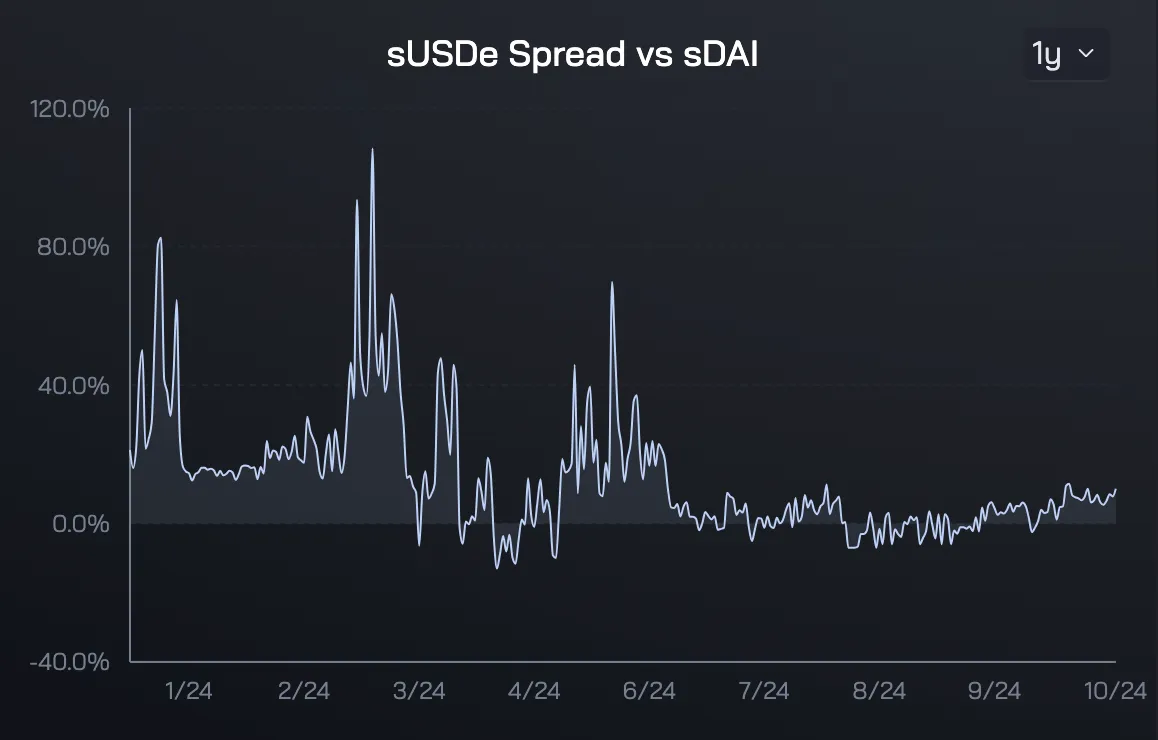
Source: Ethena
Fortunately, Ethena and Sky’s relationship extends beyond competition, as there are several complementary aspects. Ethena’s on-chain tokenization of its spot-futures spread strategy has found substantial success largely due to the high-yield ENA reward program. To support this demand, Sky has established a credit line via Spark’s Morpho Vault. Currently, a total of $400 million in $DAI has been allocated to this vault, generating $35 million in annual revenue, with Sky benefiting from the borrowing rates paid by Ethena users.
Even if Ethena’s reward program scales back, demand for Sky’s lending is likely to remain strong. Ethena’s protocol is built primarily around a spot-futures spread strategy, which would sustain loan demand even if incentives decrease. This would allow Sky to solidify its position as a key credit provider, further accelerating $DAI adoption. The DSR/SSR has already become a baseline interest rate across various third-party protocols, enhancing $DAI’s utility and expanding Sky’s influence within the DeFi ecosystem. As $DAI cements itself as an essential backend for on-chain services, Sky’s market presence and usage is expected to grow even further.
Lastly, while a somewhat tenuous link, the Federal Reserve’s recent rate cuts could be another factor contributing to $MKR’s underperformance. On October 18, the Fed lowered its benchmark interest rate by 0.5 percentage points, from 5.25–5.5% to 4.75–5.0%. Typically, rate cuts are viewed positively for risk assets like crypto; however, for Sky, which operates as a DeFi lending protocol, this move could potentially create headwinds. This is because Sky’s primary revenue source is the stability fee collected through CDPs (Collateralized Debt Positions) when users borrow $DAI or $USDs.
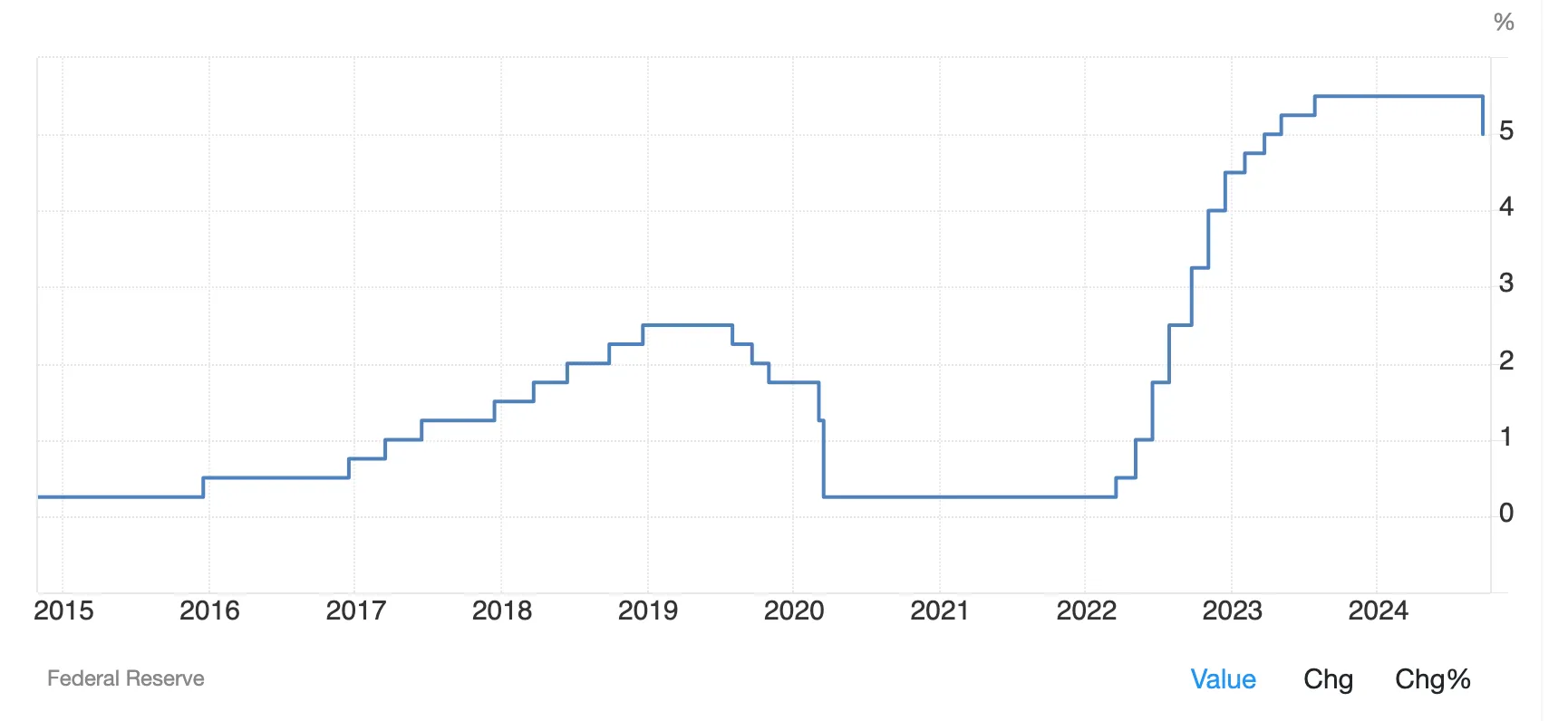
Source: Tradingeconomics
This stability fee represents a significant portion of Sky’s revenue, amounting to $309 million out of its $313 million annualized revenue (98%). In line with the Fed’s rate cuts, Sky may find it necessary to continue adjusting its stability fees downward. Reflecting this trend, the DeFi sector’s benchmark interest rate dropped from 5.44% in September to 4.76%, leading Sky to reduce Spark’s lending rate from 7% to 6.5% and the DSR (DAI Savings Rate) from 6% to 5.5% on September 26. Meanwhile, the SSR (Sky Savings Rate) was increased by 0.25%, likely to encourage conversions from $DAI to $USDs.

Source: Sky Forum

Source: Blockanalitica
With lower market interest rates, borrowing costs across the sector decrease, raising the risk that borrowers may shift to services with more competitive rates if Sky does not adjust its fees accordingly. This could directly impact Sky’s profitability, as stability fees constitute the majority of its revenue. Consequently, reductions in these fees could erode Sky’s revenue and, by extension, $SKY’s investment appeal. At present, most of Sky’s pools operate within a stability fee range of 4.5%–8%.
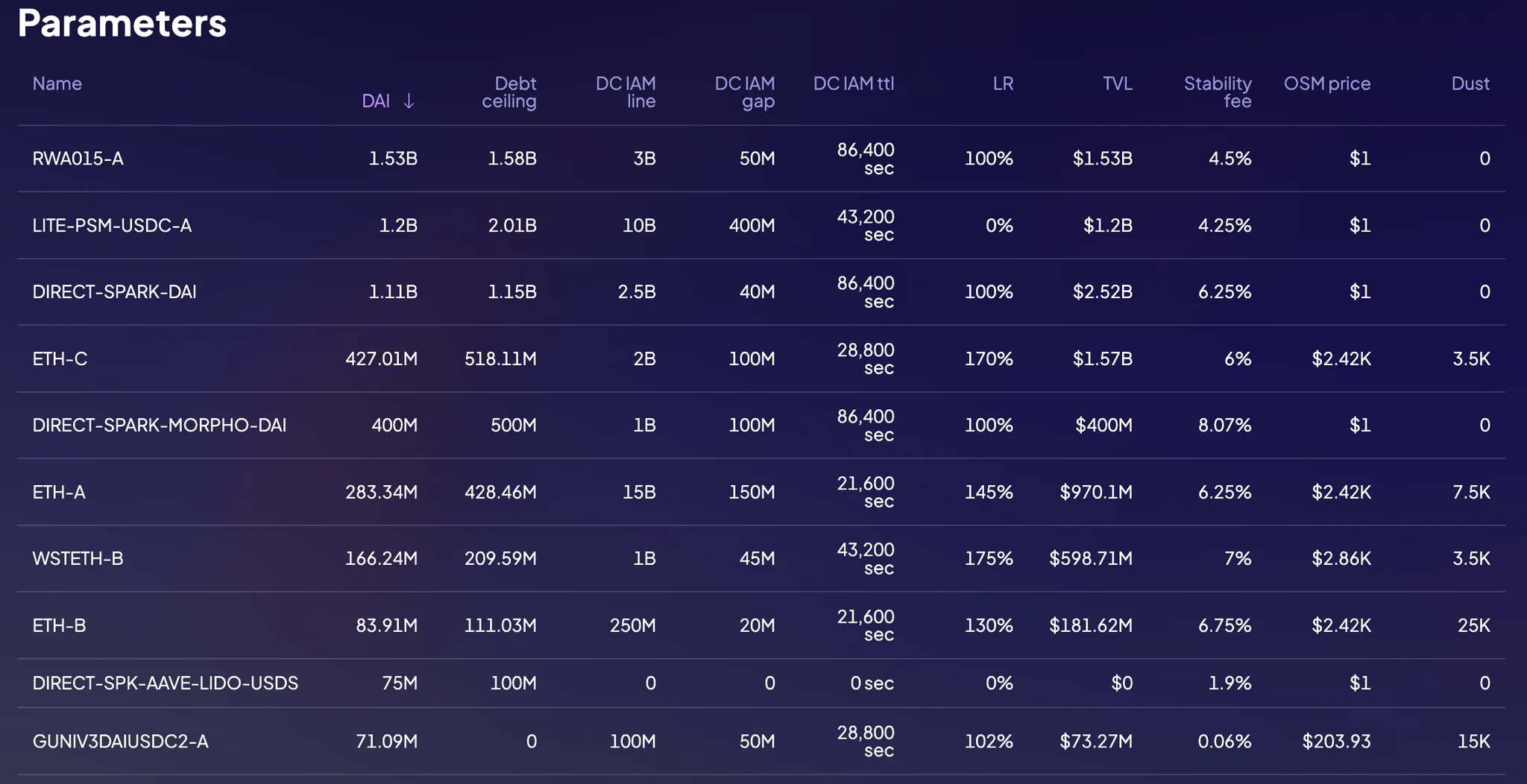
Source: Sky
Sky’s annualized revenue over the past 30 days is approximately $312 million, placing it among the top 10 protocols across the entire blockchain and dApp ecosystem. Within Ethereum’s DeFi landscape, Sky ranks as the third-highest revenue-generating protocol, following only Uniswap and Aave. Notably, Sky’s year-to-date net revenue for 2024 stands at approximately $125 million. After operating expenses of $82 million, net income is estimated at $44 million. Given that most crypto projects struggle to achieve profitability, Sky’s impressive financial performance places it firmly among the industry’s top performers.
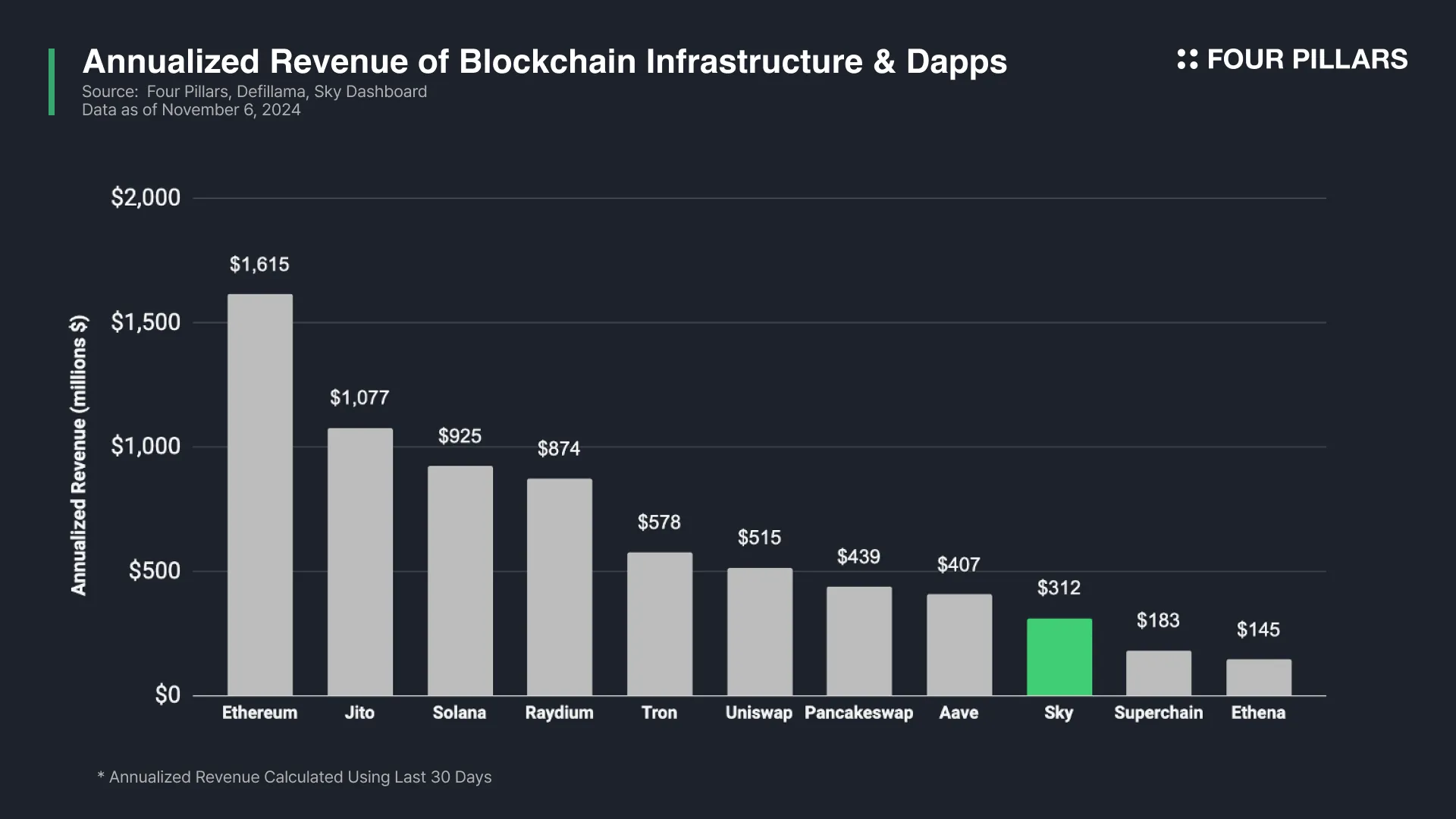
Sky’s revenue and net income have shown steady growth since 2022, with revenue increasing from $76 million in 2022 to an estimated $240 million YTD in 2024—a 213% rise over two years—while net income surged from $19 million to $44 million over the same period, reflecting 131% growth. Importantly, these 2024 figures cover only 10 months, indicating that the actual annual growth rate could be even higher. Furthermore, a significant portion of this net income is earmarked for direct distribution to token holders through $MKR burn mechanisms and the Seal Engine, as discussed in detail in Section 3.2.
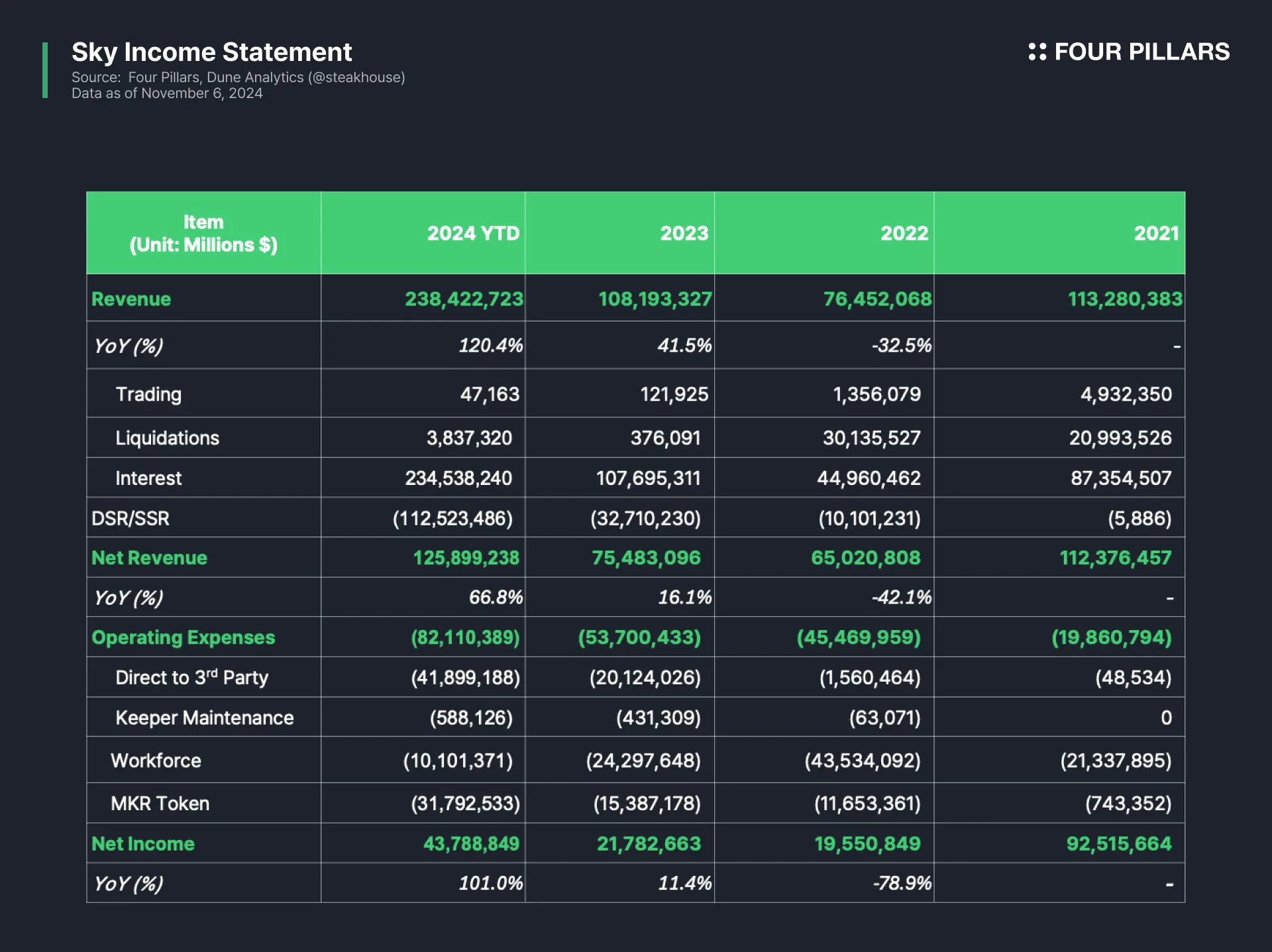
As of November 6, Sky’s revenue multiple stands at approximately 3.3x, markedly lower than that of Uniswap, Aave, and Ethena. This valuation reflects lingering market concerns over previously discussed uncertainties and biases, creating a highly attractive valuation opportunity. However, we believe this undervaluation is unlikely to persist, as the factors covered in the following sections are expected to prompt a revaluation of Sky in the crypto market.
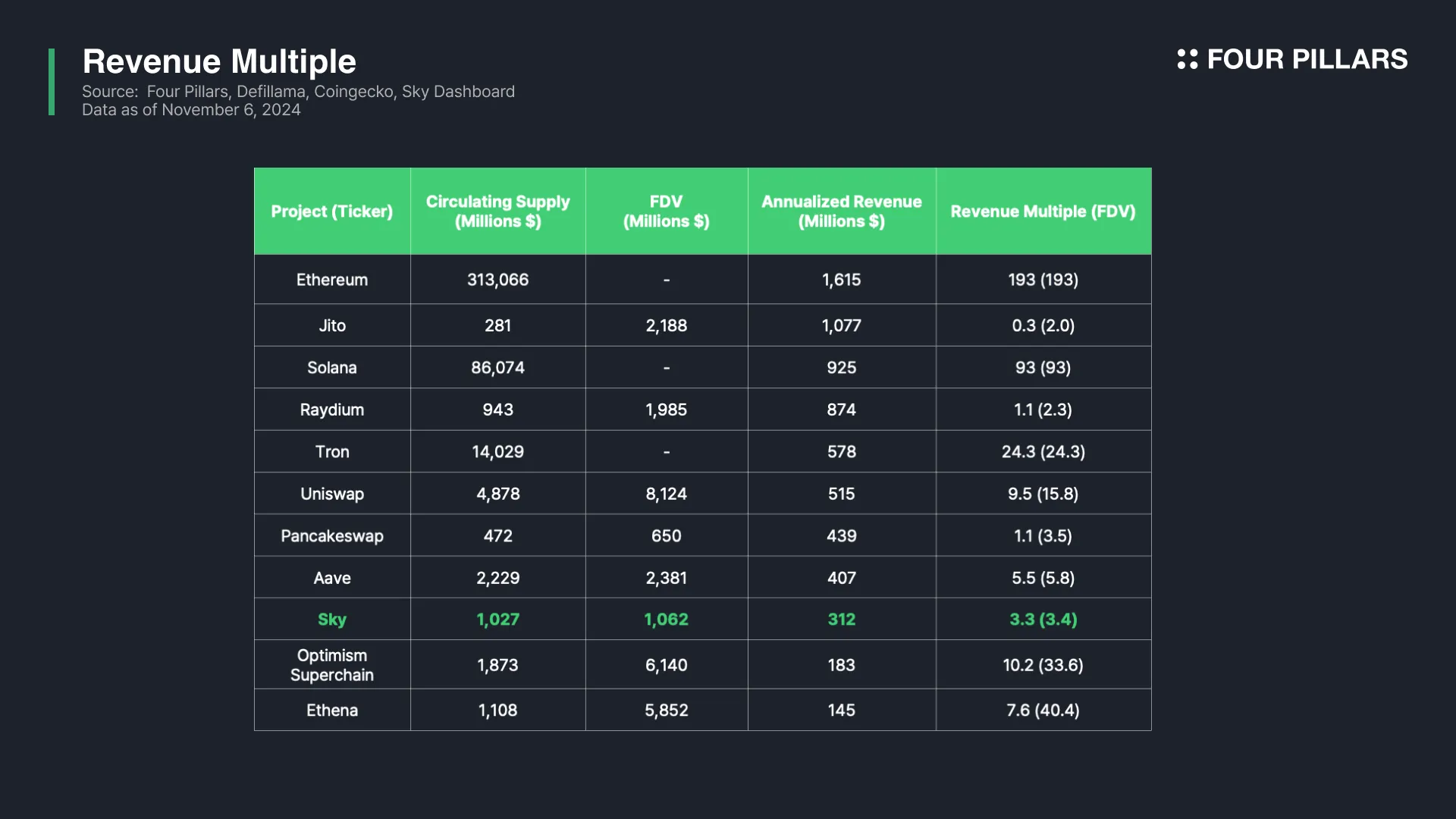
As mentioned above, the Endgame represents Sky’s ambitious long-term roadmap to expand $DAI issuance to $100 billion. Spanning four phases, Endgame encompasses brand and token rebranding, the introduction of the Seal Module (fee switch), the expansion of the SubDAO ecosystem, the launch of an independent L1 blockchain, and finally, the establishment of a fully decentralized autonomous governance system. Each phase features critical initiatives outlined below.
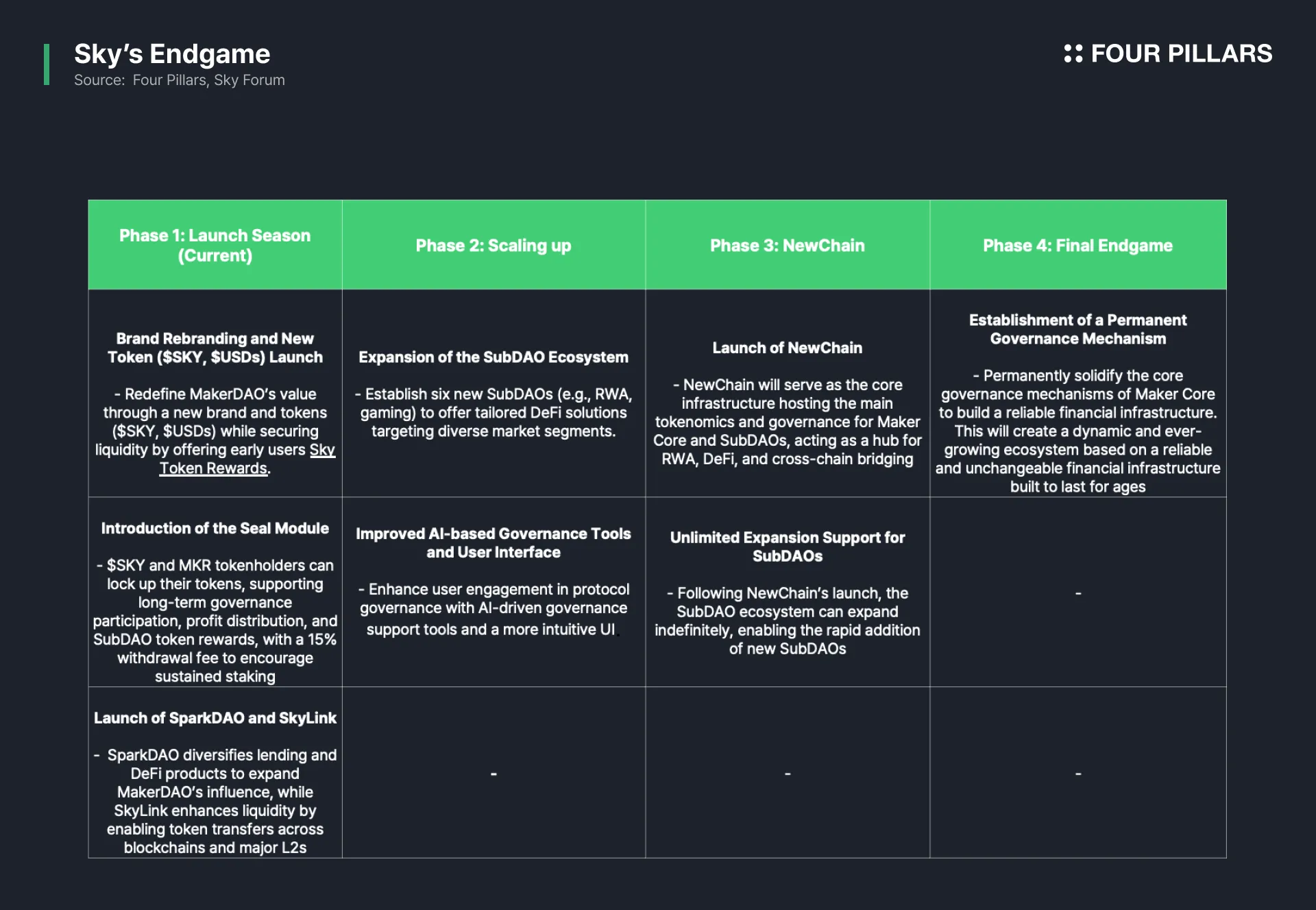
While Endgame holds transformative potential for Sky, its extended timeline makes immediate market revaluation challenging, particularly as Phase 1 alone has taken over two years to implement. However, several ongoing initiatives—following the recent rebranding and major product launches—offer compelling short-term catalysts.
3.2.1 Introducing a Revenue Distribution Mechanism via the Seal Module
The Seal Module is a fee switch module for $SKY and $MKR holders, similar to shareholder dividends. Participants can stake $SKY and $MKR to receive $USDs rewards and use the staked assets as collateral to generate additional $USDs. With the upcoming launch of Spark, Sky’s first SubDAO and lending platform, holders will also have the option to receive rewards in $SPK instead of $USDs.
The Seal Module allocates 25% of Sky’s net income to holders, with 15% of $SPK issuance reserved for this module. This turns $MKR / $SKY from mere governance tokens with ambiguous utility into income-generating assets with a direct share in protocol earnings. As of YTD 2024, this could translate to around $10~$15 million in distributions to $MKR holders.
An initial 5% exit fee applies to the Seal Module, increasing by 1% every six months, reaching 15% after five years. This structure incentivizes early participants to commit to long-term staking with lower fees.
3.2.2 Transitioning $MKR to a Strictly Deflationary Token
On October 31, Rune Christensen proposed converting $MKR to a deflationary token. If implemented, additional token issuance of $MKR would cease, with tokens continuously burned through the Smart Burn Engine (SBE) introduced in July 2023, gradually reducing its total supply. Adjustments would only be made if liquidity shortfalls threaten $DAI and $USDs stability. This transition to a deflationary model is expected to create long-term scarcity and boost value for $MKR/$SKY.
3.2.3 Expanding into the Solana Ecosystem
Sky plans to extend $USDs and $SKY into Solana through the Wormhole bridge, initially distributing up to 2 million $SKY weekly through an LP incentive program. This move enables Solana-based DeFi protocols like Kamino Finance and Solend to adopt the SSR integration program pioneered by Aave (see Section 3.2.4), potentially positioning $USDs as a leading stablecoin within the Solana ecosystem. Additionally, this initiative is also anticipated to support the future launch of SkyLink.
3.2.4 Launch of the Sky Aave Force Flagship Program
Sky is set to launch the “Sky Aave Force” flagship program in partnership with Aave. Through this program, Sky will launch a $USDs market on Aave that stacks both Sky’s USDS Savings Rate (SSR) and Aave’s market interest rates. This integration allows depositors to benefit from the reward mechanisms of both protocols, with incentive boosts provided by Aave and $SPK airdrops once Spark is live. The Sky Aave Force program is expected to significantly enhance $USDs issuance and liquidity and is likely to play a crucial role within the DeFi ecosystem.
Sky has established a robust brand in the crypto industry, backed by years of proven experience, earning strong trust from investors and market participants alike. As Syncracy Capital Co-founder Ryan Watkins stated, $DAI possesses a monetary premium, which serves as a core indicator of its network effect and value capture potential. This monetary value is a crucial asset that can only be achieved through years of consistent usage and stability.
The protocol’s sustainability is assessed not through theoretical design but by proven performance in the actual market. Over the past eight years, Sky has weathered various economic shocks and volatility, continuously demonstrating resilience and building trust. $DAI remains the longest-running decentralized stablecoin, a track record that creates a moat that no other project can simply fork or replicate in the open-source ecosystem. Thanks to this enduring stability, Sky has long held a leadership position in the decentralized stablecoin sector, with a combined market cap of $DAI and $SKY now reaching more than $5.6 billion.
Sky’s market leadership is further reinforced by its widespread adoption and deep market penetration. $DAI is not only the most widely listed decentralized stablecoin but is also deeply integrated across countless DeFi protocols and dApps. Its low cost of capital are supported by prudent risk management and monetary functionality across diverse use cases. Finally, Sky’s ability to generate real demand without relying on incentive programs highlights its sustainable edge in a competitive landscape.
Two years after unveiling the Endgame strategy, Sky is emerging from a period of quiet with renewed momentum. Major initiatives are coming to fruition, and a series of short-term catalysts are aligning to drive growth. Given these developments, the case for renewed attention on Sky is compelling. As the DeFi Renaissance gathers pace, Sky is well-positioned to stand at its forefront.
Dive into 'Narratives' that will be important in the next year